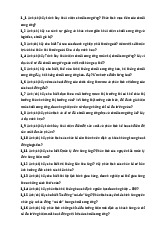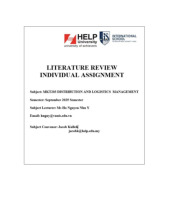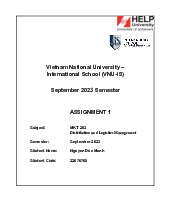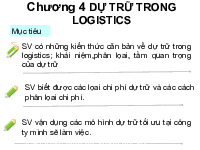



















Preview text:
1. Introduction
Logistics management takes a vital role within modern supply chain management (SCM).
Based on the Council of Supply Chain Management Professionals (CSCM), logistics is
combined by the planning, implementation, and control of the flow and storage of goods,
services, and related information from the point of origin to the point of consumption,
including handling reverse flows, in order to meet customer meets and wants. This statement
embodies multiple factors: planning, implementing, controlling; efficiency and effectiveness;
forward and reverse flow; storage; On top of that, the informational component; all with the
final goal of satisfying customers. In this essay I critically illustrate each of these features 2. The Factors: 2.1 Planning Definition & Role
Logistics covers how you manage your product from creation to distribution. Logistics
planning involves refining those processes to account for the ideal use of your systems,
equipment, and storage facilities to create a seamless system.
Logistics planning is most effective for companies that produce physical products and move
them through a multi-step supply chain. For example, factories, warehouses, and retail stores
can improve operations across the board to create a more stable and efficient organization geared for future growth. Evidence
A huge public hospital in Thailand faced challenges in transporting medical products to
numerous internal departments, providing a good example of logistics planning. The old
system had fragmented deliveries, redundant vehicle trips, and high operational costs. These
inefficiencies were mainly the result of inadequate delivery route planning and demand
allocation. To address this, the hospital implemented a centralized logistics planning
framework (Dankamned & Niemsakul, 2020). Trade-Offs and Challenges
Forecasting uncertainty: over-forecasting results in excess inventory and costs, while under-
forecasting causes stockouts and consumer displeasure.
Strategic vs. tactical misalignment: Long-term facility investments can conflict with short- term response.
Global pandemic: Huge impact on the supply chain management, by fluctuating the demand
and supply of goods&service.
Holiday rush: Unpredictable demand leads to inability to make the plan. 2.2 Implementation Definition & Role
Implementation is the execution of planned logistics: procurement, transportation, storage,
handling, order fulfillment, information systems in operation process. It involves developing a
realistic strategy and building strong partner relationships. Evidence
A realtime example of logistics planning can be found in the SmartRoutes case study with
Transvalair, a UK-based logistics firm. Transvalair implemented a route-planning and delivery
management platform to enhance oversight and decrease operational costs. By incorporating
digital planning tools, the company was able to automate route design, account for vehicle
capacity and time-window constraints.
Trade-Offs and Challenges
Costs versus Service: Faster transportation and more frequent deliveries cost more.
Labour shortage: The shortage in workers would lead to inability to be efficient at work.
Reverse flows are erratic, with unknown time and quality, making efficient implementation difficult.
Integration of new technology: These factors placed a huge challenge to the implementation
step by challenge worker to adapt to the new environment 2.3 Controlling Definition & Role
Control is the process of managing, analyzing and adjusting the activities of logistics like
monitoring the performance(KPIs), evaluating operations to ensure planning and
implementation achieve ultimate goals: measurement (KPIs), feedback, corrective actions, continuous improvement. Evidence
The Tanzanian public health supply chain reform provides a clear example of logistics
control. By using electronic logistics management information system (eLMIS) and the
establishment of a Logistics Management Unit (LMU) to actively manage and use data,
improved inventory, distribution, and performance control. Stockout rates fell significantly
after implementation, from 32% to 23%, and the number of prolonged stockouts (>7 days) fell
from 24% to 15%. At the same time, supply chain performance increased (from 68% to 77%),
while the cost per performance unit decreased.
Trade-Offs and Challenges
Over-control can lead to inflexibility, and delayed feedback reduces the ability to correct.
Inefficient operation: Poor warehouse management, demand forecasting will lead to
numerous downside for the firms.
Maintaining customer satisfaction: Biggest challenges for modern companies when the
expectation of customers are increasing recently.
Measuring the correct KPIs: focusing just on cost may harm service quality, while focusing
solely on service may result in unsustainable cost increases. 2.4 Efficient and Effective
Both of these adjectives are normally used together, but they have different meanings and
sometimes conflict understanding. These factors are contrasting. If one is up, so the other is down.
Efficient refers to doing things right: minimizing cost, time, waste, resource usage.
Effective is about doing the right things: satisfying customer requirements, delivering the right
product, in the right condition, at the right time. Evidence
Sisahy Transport Co., Ltd. in Songkhla, Thailand, provides a strong example of logistical
efficiency increasing. By using a Vehicle Routing Problem (VRP) model with heuristics (2-
Opt) and route optimisation, the company reduced route operations from two trucks making
56 trips (4,281.21 km/month) to one truck making 32 trips (2,679.60 km/month). This cut
down monthly transportation costs from 25,404.95 baht to 15,900.88 baht, a 37.4% reduction
(Wongsawad & Tingsaphat, 2021). This example shows how modeling and better route
planning can directly improve efficiency by reducing waste (empty or redundant trips),
lowering costs, and increasing asset utilization.
Inversiones Karmont S.A.C. is a strong example of logistics effectiveness, having
implemented Lean Logistics principles in its distribution operations. Before the intervention,
only about 73% of orders fully met customer needs&wants; after Lean implementation, this
boost to about 92% (MDPI, 2023). Not only were orders accurately, but they were also
delivered on time and in great condition. The case illustrates that being effective in logistics
entails aligning operations with customer requirements — not just decreasing costs or
boosting speed, but also ensuring the right product in the right condition. This case illustrates
that effectiveness can be achieved through process redesign, staff training, standardization, and waste elimination.
Trade-Offs and Challenges
Increasing effectiveness (e.g. faster delivery reduces the customer waiting time-> increase
customer satisfaction) often reduces efficiency (increases cost to the owner).
Efficiency may decrease flexibility: e.g., just-in-time inventory is efficient in holding cost for
optimal inventory management, but less effective if demand prediction.
Balancing these two factors requires good management, technology, and flexible supply chain design. 2.5 Forward and Reverse Flow
This element is connected in emphasis and highly important in modern supply chain
management. Forward flow refers to movement from suppliers → manufacturer →
distribution → customer. Reverse flow refers to returns, recycling, warranty returns, refurbishment.
Flowing Forward: Well-known in the literature on logistics, it covers order fulfillment,
manufacturing supply, outbound distribution, and inbound supply.
Important metrics: Lead time, fill rate, on-time delivery, and condition are important criteria.
Reverse Flow: Increasing in significance as a result of sustainability issues, environmental
regulations, and consumer returns, particularly in e-commerce.
Important metrics: Return rate: Processing cycle time, or how quickly returns are handled.
The amount of money recovered from returned products is known as the value recovery rate.
environmental performance (rate of recycling, waste reduction). customer satisfaction with the way returns are handled. Evidence
Kian Joo Can Factory Berhad (KJCF) in Malaysia is a strong example of a forward flow from
raw material suppliers to manufacturing, distribution, and finally to customers (local and
export) (Sorooshian, Jambulingam, & Dodangeh, 2013). The company sources aluminum and
other raw materials, manufactures packaging goods, prints or processes them, and delivers
finished packaging to consumers. Their logistics performance evaluation reveals challenges
throughout the supply chain, including raw material supply delays, transportation
inefficiencies between plants, and variations in customer delivery times. Though this case
does not articulate a specific "fix" with quantitative outcome data, it vividly illustrates how
forward flow must be managed from start to finish: supply, transformation, distribution, and
final delivery are all interdependent.Addressing issues in any one stage (supplier delays, plant
capacity, transport) impacts the ability to meet customer requirements downstream.
One robust example of optimized reverse flow comes from the customer electronics e-
commerce sector, where researchers made a reverse logistics network model to handle
product returns more efficiently (Author, 2023). The model uses hierarchical clustering to
geographically group return volumes, followed by a combined integer linear program (MILP)
to illustrate where to find collection centers, how to allocate return volumes to fulfillment or
recycling centers, and so on. When compared to the firm's current reverse logistics
operations, the optimized network achieved an average cost savings of 39.9% (IFAC-
PapersOnLine, 2023). This case shows how structuring reverse flow (collection centers,
facility locations, routing, and allocation) can decrease costs while also improving return
processing performance, thereby supporting sustainability and reducing waste. Trade-offs & Challenges
In terms of quantity, quality, and timeliness, reverse flows are less predictable. Do the factors
of customers are not predictable.
Reverse logistics infrastructure (recovery, handling, and returns centers) might not exist or be ineffective.
Adding reverse flows frequently necessitates reworking networks because forward flow was
frequently optimized long ago.
Inconsistent: Fluctuation in demands and supplies will cause a big challenge to the flow of forward.
Forward flow mainly challenges are cost. Cost in shipping, in some season like holiday rush
are difficult for companies to reduce the cost.
2.6 Storage of Goods, Services, and Related Information
Storage is another big factor: inventory for physical goods, holding storage, warehousing. The
process of maintaining goods for a specific period to ensure safety and condition; but the
definition also includes inventory of information. Storage of Goods
Warehousing: cross-docking, value-added services, demand buffering, and streamlining
operations (seasonal demand, lead times).
Data: Sorting, quality checking, disassembling, and storing returns all demand space, which
raises the cost per item. This makes warehousing expenses in reverse distribution nontrivial,
according to The Role of Transport in Reverse Distribution Chains.
Storage of Information (and related information flows)
Orders, predictions, demand data, tracking, and status updates,real-time data are among the
information needed for planning, carrying out, and managing. Electronic Logistics
Management Information Systems(eLMIS) and data ware house are the place to centralize the
data across every place in the logistics. Evidence
A case study in Thailand with ABC Company provides a robust example of warehousing
effectiveness, as it combined ABC-product category, layout redesign, and visual management
to overcome its picking operations (Khluiprasert, Raothanachonkun & Others, 2021). By
reorganizing product slots according to ABC classification (high-activity items closer to
dispatch), adding an extra access door, and reconfiguring pallet layout, warehouse capacity
was increased significantly (from approximately 808 pallets to 2,480), and picking delays
were reduced by nearly 50%. These improvements demonstrate that well-designed warehouse
layout and slotting, mixed with operations controls (visual signs, improved access), can result
in significant increases in efficiency, labor savings, and throughput.
A logistics company Rahimafrooz in Bangladesh had trouble managing its operations due to
fragmented information systems is a strong example about storage of information. To address
these issues, the company mixed its logistics information systems with corporate resources in
an effort to align operations and increase efficiency.The integration entailed coordinating
logistics data with other corporate features like inventory management, procurement, and
sales. By centralizing information, the company hoped to improve data correctness and
accessibility across departments.Following integration, the company observed improvements
in operational efficiency, cut down information discrepancies, and better coordination among departments. Trade-offs & Challenges
Costs associated with keeping inventory (items) include handling, obsolescence,warehousing and storage expenses.
Processing and storing information requires investments in IT systems and qualified
staff.Maintaing for technologies and infrastructure.
Errors, delays, and misunderstandings are caused by inadequate information systems or
improper storage.Data inaccuracy and data private.
2.7 Between Point of Origin and Point of Consumption
“Between point of origin and point of consumption” defines the multi dimension:
goods/services must move from their point of beginning(supplier, manufacturer) to final
consumers. Also the reverse can move from user back to producers and sellers. Evidence
Deere & Company, a dominant manufacturer of agricultural and construction machinery,
exemplifies effective logistics management from origin to consumption. To deal with seasonal
demand fluctuations and inventory inefficiencies, Deere introduced direct shipments from
manufacturing facilities to distributors, improved cross-docking operations, and enhanced
inventory management through advanced predicting techniques. These planning and
operational enhancement reduced supply chain costs by 10%, boosted dealer inventory
turnover, and ensured product availability during peak seasons. This case shows how strategic
management of the flow of goods from suppliers/manufacturers to end users can improve
efficiency, lower costs, and increase customer satisfaction (Logistics Bureau, 2025). Trade-offs & Challenges
Along the chain, there are significant variations in distance, shipping method, and handling
lag times. So the handing time is a crucial factor to meet customer satisfaction.
Reverse logistics are made more difficult by geographically scattered sources of returns.
International or cross-border flows may be impacted by trade or regulatory restrictions of each nation.
2.8 Meeting Customer Requirements
This is the combination of several factors: planning, implementation, control,
forward/reverse, storage, information flows are in service of customer requirements. The
factors that count as customer requirements are time, place, condition, information, cost/price,
reliability, responsiveness, sustainability increasingly. Evidence
In summary, Amazon is a clear example of a company that fully serves customer requirements
throughout its supply chain. Amazon ensures that things are handled to the correct location on
time by establishing a wide network of storage and a strong delivery system, as well as giving
constant tracking information to increase reliability. They also optimize costs to provide
competitive pricing and streamline the return process, exhibiting responsiveness and
dedication to client satisfaction. Amazon has recently concentrated on eco-friendly packaging
and delivery trucks to meet growing customer demand for sustainability. Trade-offs & Challenges
Customer requests (such as very fast shipping and free returns) can be costly; it is critical to
balance what customers value vs what the company can afford.
various consumers require various degrees of service; segmentation and customization add complexity.
Rising demands (e.g., real-time tracking, sustainability) necessitate increased skills.
3. Integrated View & Evidence
To demonstrate how all of the pieces are interconnected, below are case examples and data:
Toyota's logistics case illustrates the way how the company combines several factor planning,
implementation, control, and information to integrate all features of its supply chain. Toyota
takes advantage of milk-run inbound logistics and enhanced planning tools to coordinate
suppliers, warehouses, and production, cut down lead times and costs. Real-time information
systems connect procurement, transportation, and warehousing management, enabling
proactive decision-making and more efficient production. This combination ensures that parts
flow efficiently to factories, while return and recycling programs support reverse logistics. As
a result, Toyota now has a tightly connected system from suppliers (point of origin) to
customers (point of consumption), allowing it to meet demand more consistently and
strengthening its competitive advantage.
4. Criticisms & Improvement
Predictability and Uncertainty: Many aspects, particularly reverse flow, are highly uncertain.
This impairs planning and execution.
Cost versus Service Trade-offs: Firms that attempt to maximize service in all aspects
frequently have cost overruns or inefficiencies. The evidence demonstrates that segmenting
service levels is the optimum strategy.
Systems and IT capability: Without proper information systems, the "related information"
element fails; many organizations are slow to adopt digital technologies in reverse logistics.
Information Secure: Lacking security in information privacy may lead to huge drawbacks and
disadvantages for the company.
Warehousing: Low quality infrastructure or shortage in workforce would lead to inefficient
operation. Would come to the point of low customer satisfaction.
Sustainability and reverse logistics are underdeveloped in many businesses, yet they are on the
rise. Legislation (environment, WEEE, and EPR) is driving adoption. 5. Conclusion
Logistics management is a critical component of modern supply chain management, extending
far beyond basic transportation and warehousing activities. It combines planning,
implementation, and control, while maintaining efficiency, effectiveness, and responsiveness.
One key takeaway is that logistics must now account for both forward and reverse flows.
Forward logistics is concerned with delivering goods and services to customers in a reliable
manner, whereas reverse logistics has grown in strategic importance as a result of
sustainability pressures, environmental regulations, and the rapid expansion of e-commerce
returns. According to recent literature, organizations that successfully integrate reverse
logistics into their networks not only recover value and reduce waste, but also increase
customer trust and regulatory compliance.
To summarize, good logistics management entails developing holistic capabilities such as
strategic planning, dependable implementation, adaptive control, integrating forward and
reverse flows, and investing in both physical and informational infrastructure. When all of
these elements are aligned with customer needs, businesses can gain not only cost advantages,
but also long-term competitive and sustainable value. 6. References 1.
Inbound Logistics. (2022, December). Logistics planning: Definition, types,
importance, and strategies. Inbound Logistics.
https://www.inboundlogistics.com/articles/logistics-planning/ Inbound Logistics 2.
Inbound Logistics. (2024, December). Logistics management: Definition, functions,
and benefits. Inbound Logistics.
https://www.inboundlogistics.com/articles/logistics-management/ Inbound Logistics/ 3.
Rakyta, M., Bubenik, P., Binasova, V., Micieta, B., & Staffenova, K. (2022). Advanced
Logistics Strategy of a Company to Create Sustainable Development in the
Industrial Area. Sustainability, 14(19), 12659. https://doi.org/10.3390/su141912659 4.
SmartRoutes. (n.d.). Logistics route planning: Case studies. SmartRoutes. Retrieved
from https://smartroutes.io/blogs/case-studies/logistics-route-planning/ 5.
Logistics Bureau. (n.d.). 7 mini case studies: Successful supply chain cost reduction
and management. Retrieved from https://www.logisticsbureau.com/7-mini-case-
studies-successful-supply-chain-cost-red uction-and-management/ 6.
DecisionBrain. (n.d.). Milk-Run Inbound Logistics Optimization for Toyota.
DecisionBrain. Retrieved September 30, 2025, from https://decisionbrain.com/toyota/ 7.
Wipawan Dankamned&Jirawan Niemsakul. (n.d.). Transportation Planning for
Medical Products. Journal of Industrial Technology and Innovation (JIT Journal).
Retrieved from https://ph01.tci-thaijo.org/index.php/jit_journal/article/view/241459 8.
(Savaliya Vivek). (n.d.). E-commerce supply chain efficiency[PDF]. International
Journal of Business Management & Practices. Retrieved from
https://journal.multitechpublisher.com/index.php/ijbmp/article/download/1243/1830/7 096 9.
Marasi Mwencha & James E Rosen & Cary Spisak & Noel Watson & Noela Kisoka &
Happiness Mberesero(2017). Upgrading Supply Chain Management systems.
PubMed. Retrieved from https://pubmed.ncbi.nlm.nih.gov/28877933/ 10.
Rawich Wongsawad & Chark Tingsaphat. (2021.Jun). Efficiency Improvement for
Logistics System. TNI Journal of Business & Administration. Retrieved from
https://so06.tci-thaijo.org/index.php/TNIJournalBA/article/view/248784 11.
Deysi Llanos-Solorzano & Yenipher Dayana Barboza-Quispe & Ruben Felipe Vidal
Endara(2023). Case Study: Implementation of Lean Logistics. Logistics MDPI.
Retrieved from https://www.mdpi.com/2673-4591/83/1/17 12.
Amila Thibbotuwawa & Pamal R. Nanayakkara & W. Madushan Fernando &
Madushan Madhava Jayalath & H. Niles Perera & Peter Nielsen(2023). A Reverse
Logistics Network Model. ScienceDirect. Retrieved from
https://www.sciencedirect.com/science/article/pii/S2405896323019675. 13.
Thanatcha Khluiprasert & Pairoj Raothanachonkun. (n.d.). Increasing Efficiency of
Warehouse Layout. BUU Institutional Repository. Retrieved from
https://ir.buu.ac.th/dspace/handle/1513/658 14.
Md. Salah Uddin Rajib & Md. Shariful Alam & Md.
ShamsulArefin(2013,Jan).Integrating Logistics Information Systems. SSRN.
Retrieved from https://papers.ssrn.com/sol3/papers.cfm?abstract_id=2203719 7.Appendix



